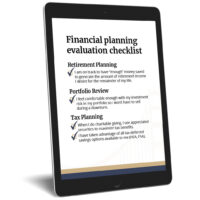
Lessons from SVB’s and First Republic Bank’s failures: protect your wealth with a fiduciary
When two of the Bay Area’s largest banks fail within a few months of each other, people take notice. Stories of Silicon Valley Bank (SVB) and First Republic Bank collapsing shook the financial world, along with investor confidence.
Both of the forced closures drew superlatives like “second-largest in history” and “largest since 2008”. Much like in 2008, these events tell a story of risky lending practices, flawed regulation, and lack of oversight, with everyday consumers being the biggest victims.
What’s the story behind SVB and First Republic Bank’s failures?
The Federal Reserve called Silicon Valley Bank’s failure a “textbook case of mismanagement”. There were certainly some fishy things going on at First Republic too, but the specifics differed.
Both institutions suffered liquidity problems and dangerously high ratios of uninsured deposits. And following on the heels of SVB’s public debacle, First Republic faced added mistrust and skepticism.
SVB got themselves into trouble mainly through offering loose loan terms with minimal collateral or due diligence. First Republic Bank also suffered from mismanagement woes; for example, the practice of awarding bonuses to brokers for bringing additional funds into the bank. Then they paid consumers below-market interest, and lent out that money charging a much higher interest rate on it. While this practice of “earning the spread” is a normal part of how banks make money, First Republic took it too far.
At the same time, bank employees would entice customers with unbeatable mortgage terms in exchange for depositing cash at the bank. It worked. First Republic brought in millions worth of high-profile accounts, steadily increasing the number of uninsured deposits (above the FDIC ceiling of $250,000).
But dipping economic conditions and rising interest rates drove the value of their loans way down. This challenging environment—formed by the combination of economic downturn, low consumer trust, and increased attention on banks—amplified the consequences of mismanagement, leading to their eventual downfall.
As news spread that the bank was suffering, their stocks tumbled and withdrawals soared. The FDIC announced First Republic Bank’s closure on May 1, 2023 and sold its assets to JPMorgan Chase at bargain basement prices.
Autopsy of a failed bank: red flags to look out for
A public autopsy of First Republic’s demise revealed a longstanding and untreated disease. An illness that, although unrelated to its death, was harmful to the people who counted on the bank.
More than just a place to park your money, many investors look to banks for long-term financial planning and wealth management guidance. At least, they hope to be able to. Unfortunately, though, this disease is not an isolated case—it tends to lurk in places where profit is the number one motive.
With all that you’ve worked for (not to mention your future) at stake, you deserve a financial partner you can trust. To help you find the right fit, here are some red flags to look out for and avoid.
Hidden incentives
Overinflated commissions (First Republic’s 1.15% payouts far exceeded the “norm” of 2-10 basis points) harm consumers financially. Hidden incentives blatantly violate consumer trust, all for the benefit of the bank, its employees, and its shareholders.
Conflicts of interest
In one glaring conflict of interest, SVB’s CEO served on the board of the organization regulating the bank, the San Francisco Fed. And based on testimony, it seems likely that similar conflicts of interest existed within the wealth management divisions of First Republic bank.
Incentivization of a firm’s products also creates a conflict, since paying bonuses encourages brokers to recommend whatever they get a kickback for, instead of what’s best for the client.
Lack of transparency
With such overblown broker incentives, it raises the question – why weren’t customers aware of these ultra-high payouts? More likely, they were informed, but it was buried somewhere in a 25-page disclosure.
These situations may not have happened to you specifically, but these hidden payouts, lack of transparency and conflicts of interest seems to be endemic at firms where use of the firm’s products are incentivized. And at the end of the day, you deserve a financial plan that’s built to serve you, not the bank’s bottom line.
How does the fiduciary standard protect investors?
Major financial institutions present themselves as shiny pillars of the community—and they do play an important role. But as the abuse leading up to the Global Financial Crisis (and in First Republic’s case) shows, we can’t assume that a bank will put the consumer’s interests first. And since the bank is not a fiduciary, they are not obligated to do so.
The fiduciary standard protects investors by holding advisors accountable to a higher ethical standard than the lesser suitability standard that broker-dealers follow. Regulated by the Securities and Exchange Commission (SEC) and/or state securities regulators, the fiduciary standard requires advisors to put client’s interests above their own.
Any firms held to the fiduciary standard must:
- Put the client’s best interests first
- Act with the prudence, skill, care, diligence, and good judgment of a professional
- Not mislead clients and to provide conspicuous, full and fair disclosure of all important facts
- Avoid conflicts of interest and to fully disclose and fairly manage, in the client’s favor, any unavoidable conflicts.
Protect your wealth by working with a fiduciary
When you’re seeking financial guidance to protect and grow your wealth, trust naturally plays a major role. People are often attracted to the name recognition of larger firms. But when the credibility of those “trusted names” comes under scrutiny, it can be tough to feel like you’re in the best possible hands.
Thanks to the fiduciary standard, trust and ethical principles are literally built into the business model of a Registered Investment Advisory (RIA) firm. Here’s what sets these firms apart:
No conflict of interest
As registered advisors, independent firms can access and review research objectively since they’re not acting as brokers or salespeople for any product or service placements. They’re solely investment advisors and act as fiduciaries at all times. The best independent fiduciary advisory firms have investment research processes that are objective, qualitative and quantitative, and are not influenced by investment product companies.
Complete transparency
Any financial professional who provides guidance for personal investments must share their Client Relationship Summary (Form CRS).
This form provides a full rundown of the firm, including:
- The types of services offered
- The required standard of conduct associated with those services
- Fees and other costs
- Any existing conflicts of interest
- Whether the firm and its financial professionals have reportable legal or disciplinary history
- How to get more information about the firm
Before working with any professional, check their credentials and CRS form.
View our Form CRS here.
No hidden incentives
One of the major benefits of working with an independent, fiduciary advisor is the transparent fee structure: their only revenue stream is from fees (typically a percentage of assets under management) paid by clients, based on the advisor’s fully transparent fee schedule. No commissions for selling you a specific fund, no bonuses for meeting sales goals.
Before working with a financial advisor, you can also ask them directly about their pay structure. Fiduciaries will always be “fee only”, while others might be “fee-based” meaning they can also receive commissions.
Your best interests come first
We mentioned the fiduciary standard, which is the highest standard in the industry when it comes to managing your investments and giving honest financial advice. Like all fiduciaries, we are philosophically and legally required to place your interests first, every step of the way. And since we’re not beholden to any product, that’s easy to do.
Protip: One way to spot a fiduciary advisor is to see whether or not they’re a Registered Investment Advisor (RIA). This classification identifies firms with fiduciary obligations to their client(s). You can verify their RIA registration through the state securities administrator or the Securities and Exchange Commission (SEC). If their title is “broker” or “broker-dealer”, there’s a good chance they work on a commission structure. And, rest assured that if you are working with a CFP® Professional, they are bound by their Code of Ethics to act as a fiduciary.
As a financial steward for your family or personal retirement plan, you owe it to yourself and those counting on you to find an advisor you can count on. Someone who will do what’s best for you, not for their paycheck. Finding an advisor without conflict can start with a simple conversation. Please contact one of our CERTIFIED FINANCIAL PLANNERS™ to learn more about how we may be able to guide you.
The information provided herein is for informative and educational purposes only. The use of hyperlinks to third party websites is not an endorsement of the third party. Third party content has not been independently verified. To understand how this content may apply to you, please contact a financial advisor.








